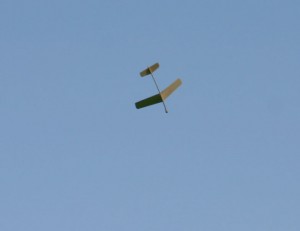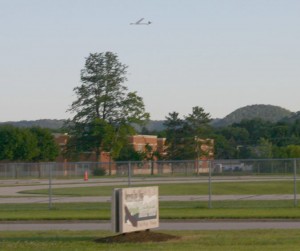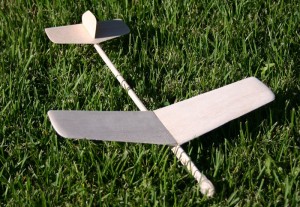
I can now say I have built all four of the Guillow’s Build-n-Fly series of model planes, but not in the recommended order. The Goldwing hand launch glider is the first in series and it was the last plane I constructed. This has been the only plane in the series that I did not modify in anyway and no wood replacement was done. The Goldwing might be the only hand launch glider kit that you find in retail outlets, other hand launch glider kits are normally purchased through the smaller companies that specialize in free flight model planes sold through mail order. If you can not find Guillow’s kits locally at a hobby shop or craft store, the kits can be found online from larger hobby vendors. Retail price is $12, but I found the kit on the Internet for under $9, there is also a 12-pack bulk pack available, $72 was the cheapest I have seen for that.

Hand launch gliders normally are made from solid balsa pieces; that is no framework and no covering needed. The largest amount of work will be sanding the airfoil-shape into the wing. I used sandpaper provided and worked my way up to finer grits of sandpaper to get a smooth surface on the wing. This will take a fair amount of time. Included in the kit is one piece of sandpaper and a small bottle of white glue but I used Duco cement just because it is what I use for most building. I was careful to get all surfaces in alignment as close as possible, this glider does not use tilted stabilzer the way some hand launch gliders do. To balance the glider it is going to take a fair amount of ballast because it has a long fuselage. I used the clay provided to arrive at the indicated balance point, and then covered the clay with hot melt glue to keep it from coming off. This has worked well so far.
Flying hand launch gliders is harder than one might think because you want the glider to climb as fast as possible and transition smoothly into a flat glide. My Goldwing glider was in trim right from the start; it will make a nice curve upwards to the right and start gliding in a gentle left circle on the way down. After throwing it a few times, I tried hooking my index finger to the back of the trailing edge to get more power in the throw. This started to crush the trailing that I had sanded very thin, so I smeared that area with glue which seemed to help.
In conclusion, I think this might be a pretty good model for a beginner to start with if they are accurate in the building and the trim adjustments. Without actually seeing an 8 year old try to launch a hand launch glider, I am not sure how well it would fly for them; some gliders are not very tolerant of bad launches. At some point I would like to try converting the glider to a catapult glider by adding a hook.
Bill Kuhl

Amazing that anything Guillow has balsa that is too light but I am sure it happens. Many handlaunch gliders have fuselages made from basswood or spruce because of the damage the fuselage suffers. Maybe you could reinforce the fuselage with thin ply, it also helps to fly over ground that is softer if possible.
Handlaunch gliders appear so simple but adjusting and throwing the glider is not easy. There is like no incidence in the wing for best glide but then there is also poor recovery. When you throw the glider it has so much speed and lift but it has to transition into a flat glide. I bank my gliders to the right and trim to circle to the left. Sometimes my launches are not good and the glider lawn darts into the ground. Making the Goldwing into a catapult glider might help, that is what I ended up doing.
Another thing I have noticed with gliders is it seems like you need to change the CG slightly on different days.
I have been concentrating more on foam gliders for kids which seem to absorb the shock better than balsa, this is one I designed from a meat tray: http://www.scienceguy.org/Articles/HammerDownCatapultGlider.aspx
Hopefully this helps.
Hello,
I’m a 74-old grandpa … looking for projects to share with 3 grandchildren.
In younger years I was an accomplished modeller.
So I bought 4 kits of the GoldWing … a built one of them.
Building was smooth. Flying was a disaster.
1. On the first attempt the glider hit the ground and snapped the fuselage between the wing and the tail.
2. I repaired the snap. Tried to fly it again. Two glides were encouraging. On the the third glide the fuselage snapped in a different place. There was a little wind … but not heavy.
My thoughts:
1. My particular fuselage was very light balsa … not stringy. Not good for the fuselage for the glider.
2. Should I reinforce the fuselage? How?
3. Test/balance the glider in absolutely still air.
4. This model is unpredictable … not a good choice for novices.
What do you think?
Interesting comments Tom. I’ll have to try and get my hands on one and give it a try. It looks like it should be okay. But I wonder if they are giving enough instruction to know how to make sure everything’s in good trim.
I found the same breakage and finicky trimming. I had a $4 Guillows glider in the plastic bag (sky streak or whatever) and I got that thing to fly 20/30 seconds with two full right circuits before landing. The Goldwing could really flew well in a straight downwind line, but the CG DID MOVE AROUND A LOT and after the fuse broke, it was done. Trimming for circular glide was by warping TE on either side depending on the turn I wanted. Seems to me the Goldwing is good tio teach sanding, airfoil and balancing, then flown for distance. But reliable circular patterns seem a step too far a reach.